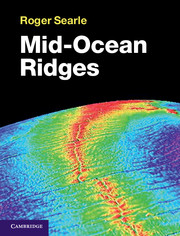Book contents
- Frontmatter
- Dedication
- Contents
- Preface
- 1 Introduction
- 2 Techniques of MOR study: a brief historical review
- 3 The oceanic lithosphere
- 4 Ridges as plate boundaries
- 5 Crustal structure and composition
- 6 Volcanism
- 7 Tectonism
- 8 Hydrothermal processes
- 9 Summary and synthesis
- Appendix A Glossary of terms
- Appendix B Directory of named features
- References
- Index
- Plate Section
4 - Ridges as plate boundaries
Published online by Cambridge University Press: 05 June 2014
- Frontmatter
- Dedication
- Contents
- Preface
- 1 Introduction
- 2 Techniques of MOR study: a brief historical review
- 3 The oceanic lithosphere
- 4 Ridges as plate boundaries
- 5 Crustal structure and composition
- 6 Volcanism
- 7 Tectonism
- 8 Hydrothermal processes
- 9 Summary and synthesis
- Appendix A Glossary of terms
- Appendix B Directory of named features
- References
- Index
- Plate Section
Summary
Ridges and plate kinematics
An important aspect of MORs is their function as divergent boundaries between tectonic plates (Figure 4.1). Plate tectonics considers the lithosphere to be broken into a number of thin, rigid caps, whose relative motions across the Earth are described by plate kinematics (McKenzie and Parker, 1967; Le Pichon, 1968; Morgan, 1968). Plate motions are described in terms of pure geometry, utilising Euler's rotation theorem that any motion on a sphere can be represented as a single rotation about an axis passing through the sphere's centre. This axis cuts the surface at two points called the Euler poles, or ‘poles of rotation’. The relative motion between any two plates is completely described by the latitude and longitude of the relevant Euler pole and the rate of rotation. The most recent global description of plate motions is given by DeMets et al. (1990, 1994) .
The trace of an Euler rotation on the surface of the sphere is a ‘small circle’ centred on the pole (Figure 4.2). Such circles are analogous to lines of latitude, which are small circles about the geographic poles. Two plates sharing a common boundary aligned along such a small circle will move relative to one another by pure slip, so the azimuth of this small circle is the spreading direction. Geologically, such plate boundaries are transform faults (Wilson, 1965; Section 4.4). ‘Great circles’ (diameters of the sphere) that are normal to transform faults meet at the rotation pole (Figure 4.2). There are two other types of plate boundary: ‘trenches’ or subduction zones, where plates converge, and ‘ridges’, where they diverge. The ridges are spreading centres and are the main subject of this book. Since MOR axes represent divergent, or spreading, plate boundaries, they are often called ‘spreading centres’ or ‘spreading axes’.
- Type
- Chapter
- Information
- Mid-Ocean Ridges , pp. 61 - 91Publisher: Cambridge University PressPrint publication year: 2013



